Last year, when the Royal School of Needlework began producing a series called “Essential Stitch Guides,” I was pretty excited! The first two books in the series, the RSN Essential Stitch Guide for Blackwork and the RSN Essential Stitch Guide for Crewelwork, I’ve already reviewed. I like them both.
The RSN Stitch Guide for Silk Shading is going to be a little more difficult to review. After reading the book cover-to-cover, I have to admit that I wasn’t in raptures over it. That’s not to say it doesn’t have some good points and some good content. I’ll give you a synopsis and touch on some pros and cons, from my point of view. Then you can decide whether or not you’ll add it to your library.
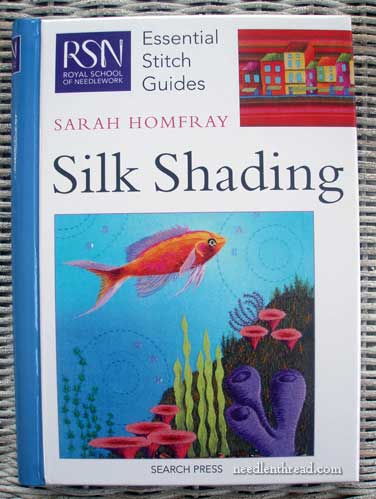
The RSN Essential Stitch Guide for Silk Shading is written by Sarah Homfray, a graduate of the Royal School of Needlework who still teaches for the RSN. The book is bound like the previous two books in the series – it’s a small book, with board covers and spiral binding, which makes it very convenient to use as an instructional book (because it stays open without any trouble).
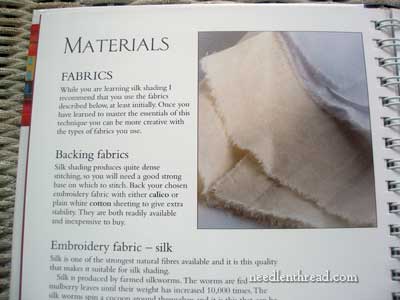
Like the previous books in the series, the book begins with a blurb on the Royal School of Needlework, followed by an introduction to silk shading and a brief history of silk shading. Then comes a nice “materials” section with tips on different types of fabric that can effectively be used for silk shading, as well as tips on backing your fabric.
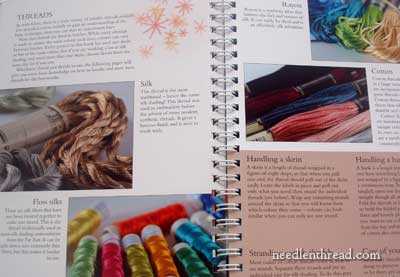
There’s a section on threads suitable for silk shading, and the author provides some good pointers on choosing different types of threads.
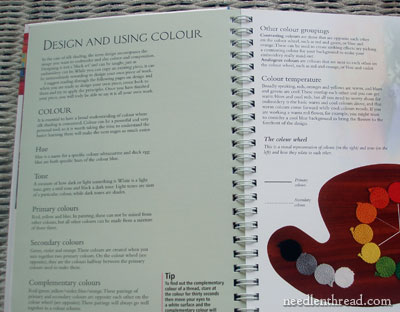
There’s a bit on color, too. This section is basic, but informative. There’s a short glossary of the essential terminology used when discussing color, which is nice to have, and a brief list of do’s and don’ts when selecting color.
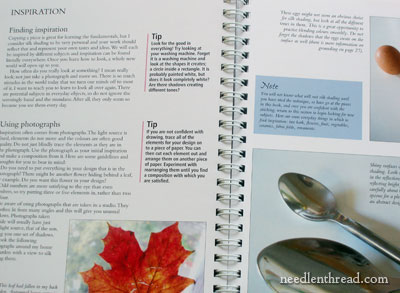
Following the discussion of color is a two-page spread on finding inspiration for silk shading. The author points out that even mundane items like eggs and spoons can make an interesting study in silk shading. She talks a bit about what to be aware of when finding inspiration in photographs and in everyday items.
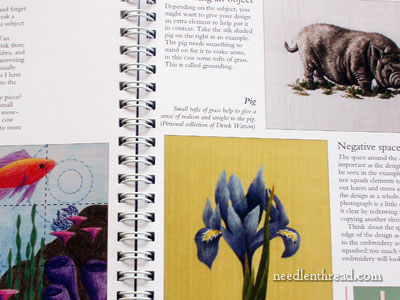
Composition is also covered in brief. The author discusses basic rules such as the “rule of thirds,” focal points, grounding objects, and the use of negative space. These are good points for anyone who hasn’t studied or read up on the subject of design, and though succinct (after all, this is a stitch guide, not a book on design), the information is good and useful to know.
The section on composition is followed by a section on color planning, tonal references, stitch direction, and stitching order. I would have liked a bit more content in this section – especially some visual instruction – as I think these questions are essential to silk shading. (I’m hoping to see some of these points really elaborated on in Trish Burr’s upcoming book on color in embroidery.)
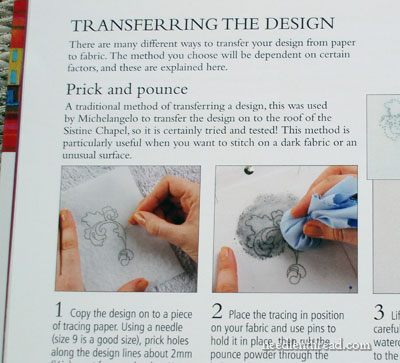
There is an extensive bit on transferring the design, the first instructions being devoted to prick-and-pounce (you’ll find this in the crewel book, too), and then other options are also discussed, like tracing, using a transfer pen (iron on), and using tacking stitches with tissue paper.
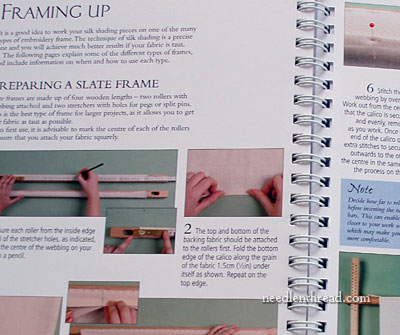
There are six pages devoted to framing up – four of which are devoted to slate frames. Scroll bars, stretcher bars, and hoops are covered in the other two pages. If you already have the crewelwork and blackwork books, this may seem like redundant information, but it’s necessary information for each book, when owned in isolation. However, since fewer people use slate frames than they do the other three methods of framing up, I tend to find the emphasis on the slate frame (which is not as commonly owned by the average stitcher, is harder to come by, is more expensive, and is more time-consuming to set up) a bit overdone. Still – if you want to do it the RSN way, then a slate frame is part of that approach.
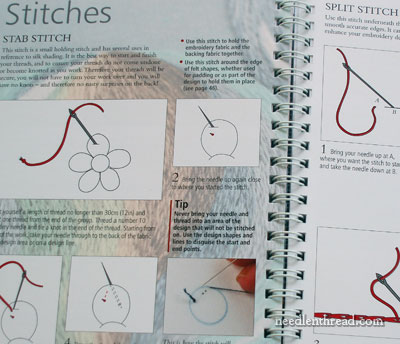
The “stitch guide” part of the stitch guide falls a bit short, in my opinion. Here, you’ll find a combination of diagrams and photos illustrating some of the stitches used to enhance silk shading projects (in addition to long and short stitch).
Why does this section fall short? I would have liked to have seen more emphasis on the methods of using the long and short stitch – like stitching in various directions with long and short stitch, blending colors and switching threads and so forth – rather than diagrams on simple stitches like running stitch and whipped running stitch. Some of these points (on stitch direction, for example) are covered a little later in the book, but it would have been nice if all these techniques had been addressed in one uninterrupted section, rather than having to flip through the book to find the instructions for different long and short stitch techniques.
I found it surprising that, for a book on shading with long and short stitch, the first stitches one comes across in the book are running stitch, whipped running stitch, and so forth. I found the whole instructional section on stitching a little broken up and disorganized.
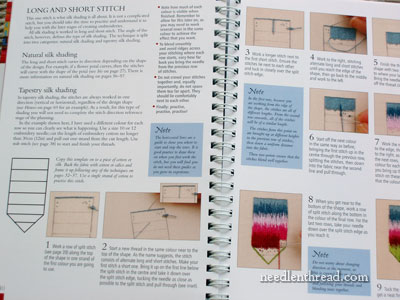
Two pages are devoted to the long and short stitch itself, stitched straight up and down (the technique known as “tapestry shading”). As stated above, a little later in the book, the author covers varying direction with the long and short stitch. While the purpose of the simple long and short stitch demonstration is just to show the movement of the stitch (the mechanics of how to do it), I’m a little disappointed in the instruction here. Clare Hanham’s book, Beginner’s Guide to Silk Shading, does a much better job on basic instruction on long and short stitch.
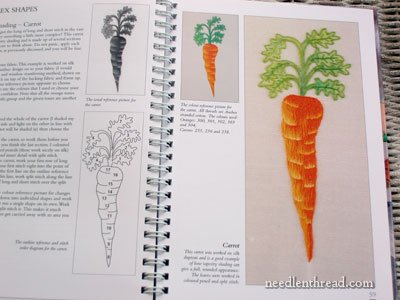
After the stitch guide section, you’ll find some exercises that demonstrate techniques of effective silk shading. There’s a little exercise involving a vase that shows directional shading (rather than straight up and down tapestry shading). There’s this carrot exercise, for shading “complex shapes” using tapestry shading. Then there’s a banana exercise that demonstrates natural shading (following the curves of the banana and its peeled peel).
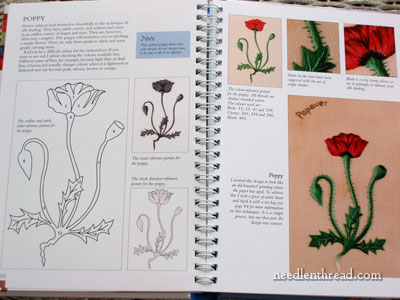
Following the vase, carrot, and banana, we get into a section called “Projects to Stitch.” Unlike the previous two stitch guides, the silk shading stitch guide has specific projects in it. Thread painting takes a lot of practice, so I like the fact that a few practice projects are included. The projects are nice – the “blue curves” project is an interesting excise in shading complex designs that are foliage-like, using natural shading; the “marbles” project is colorful, different and fun; a “poppy” project, which is ok; and an “autumn leaves” project, which is the most realistic looking project featured in the book.
Following the projects section is a section titled “Taking Your Work Further,” where the author focuses on using long and short stitch in abstract and multi-technique designs.
And then there’s an explanatory section on working with different threads and then one on working with different fabrics.
At this point, I was becoming frustrated with an overall sense of “choppiness” to the book. The instructional parts previous to this point seemed choppy, because I was flipping around looking for all the instructional points on long and short stitch. Then I arrived at this section, which talks again about threads and fabrics. There’s a materials section at the front of the book discussing threads and fabrics, and now this one at the end of the book. The reason for including the topic again here is apparently to elaborate on the notion of taking long and short stitch shading “further.” We see a needlepainted peacock feather stitched on denim and some pictures of Chinese needlepainting in this section.
Next up, we go back to specific technique instruction, in a section devoted to working with painted backgrounds (with information on painting the backgrounds), followed by a project that incorporates a needlepainted image (the face of a Native American) stitched on a painted background featuring sky, hills, a green meadow, and some teepees. There’s a nice diagram and explanation of needlepainting the Apache’s face, which is handy. It’s good to see the treatment of a face in needlepainting (something that’s rarely discussed in any other books on long and short stitch), even though this particular face is more reminiscent of carved wood than of a natural face. The author points out the detail that can be achieved in tapestry shading by changing colors and shades.
Moving away from specific technique instruction, we reach a gallery of other needlepainted pieces – a bird, some animals, some still-life – that covers a couple pages. I was disappointed in this section of the book. The pieces are ok, but fell a little short of the Wow Factor.
Then we get a section on finishing (mounting, lacing, and framing). Again, another bit of choppiness here – we’re back to instruction.
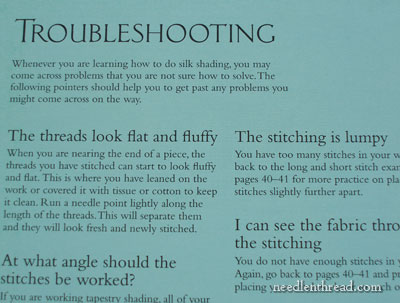
Finally, we get a section called “troubleshooting,” and this area features a list of tips to help improve our needlepainting efforts. It would have been nice if these tips had been “fleshed out” with demonstrative photos in the body of the book; treated that way, they would have served as better – and more thorough – instructional material for long and short stitch. I think it’s good the troubleshooting tips were included, but a little elaboration would have been nice.
Pros:
1. The binding is nicely done in spiral (I like that in an instructional book, though I realize other people don’t necessarily like it).
2. It has some interesting and useful content, especially in the form of highlighted tips throughout the book, the section on design and composition, and the troubleshooting tips (brief as they are).
3. It’s an affordable book to have as an extra resource in your library. There are enough good tips in it to make it worthwhile.
Cons:
1. For actual instructional purposes, especially for beginners to shading, there are better books out there. Clare Hanham’s Beginner’s Guide to Silk Shading is one of them, as well as the A-Z of Threadpainting. For advanced-beginner through advanced stitchers, Trish Burr’s books would provide better inspiration and instruction, too.
2. The organization of the book is disappointing. It lacks a logical sequence and seems choppy. Flipping around to find the various techniques involved in long and short stitch shading was rather annoying.
3. There’s not enough emphasis on the “troubleshooting” aspect of needlepainting. Silk shading is not an easy technique when it comes to achieving realistic shading, and it would be nice to see more of the troublesome aspects more clearly tackled, in an organized and logical sequence.
4. Though the author discusses tonal qualities in needlepainting and shows how a black-and-white photocopy of the original picture of the design can help the stitcher know where the different shades change, there is no specific or detailed instruction on where to work different colors & shades, on how to switch off to other colors & shades, on how to manage switching between shades in small areas or vertical areas, on working into one color and then out of it again, etc. These points are really essential to good silk shading, and I think the book could have gone into much more detail on managing color and shade changes in various stitching circumstances.
I’d say the book is a good one to have as an extra resource, but it doesn’t strike me as a “go-to” resource for silk shading. I wouldn’t categorize it as a beginner’s book. Rather, I’d describe it as a “recap” on general points of silk shading, with a lot of extra information on the peripherals, and not quite enough information on the essential aspects that would answer the questions of stitchers new to silk shading.
If you have the book already, I’d like to hear your input on it! Leave a comment below!
Where to Find It
You can find the RSN Stitch Guide for Silk Shading through the following book affiliates:
In the US, it’s available here through Amazon.
Worldwide, with free shipping, you can find it here at Book Depository.







Thank you for the help. Yesterday I discovered the book at Amazon.co.uk but was hesitating.
Buy it/don’t buy it.
I decided to wait for it is rather new. Now I know that was a good decision.
I was interested to read you comment about usage of slate frames.
The R.S.N. is here in the U.K., where slate frames are widely used, along with hoops. These are the only two types of frame mentioned in the Tutorial contained in their Software.
I also sometimes see bar frames, particularly for silk, when it has been painted
I have not seen many other frames in use, although other types are available in shops and online.
I wonder what frames are prevalent in other parts of the world?
Gwendoline
Hi, Gwendoline! Thanks for your input on slate frames – a very good point, that they are probably more common in the UK, and since the book is written there, that makes sense.
I probably should have clarified a little better. The average embroiderer just starting out in needlepainting isn’t likely to have a slate frame on hand, I’d guess.
As for the availability of the slate frame – here, stretcher bars and scroll frames are more common, because they are widely sold in needlepoint (canvas work) shops, and there are far more shops devoted to needlepointed and counted work than there are devoted to surface embroidery. So stretcher bars are pretty easy to come by, as are hoops.
In Asian countries, a version of the slate frame is used – not quite the same, but it is a laced frame, too.
As for Australia, I sure get a lot of questions asking where to find slate frames and where to find good stretcher bars, so I suspect the hoop is probably more commonly used there. I could be wrong???!
Interesting topic…. maybe something worth elaborating on later on. What’s the most prevalent form of supplying tension to embroidery work? It’d be interesting to hear answers from around the world!
~MC
Hi Mary,
After reading your review I am glad I didn’t pre-order it. I have the RSN Blackwork and Crewelwork books and think they are fabulous, so inspirational.
Did you ever consider writing your own books? You put a lot of work into this blog, and it is very easy to read and gain instruction from.
I do not do a great deal of surface/crewel embroidery, preferring the symmetry of counted thread, but I use stretcher bars pretty much for everything. I buy them at artist’s supply stores where they have wider (thus stronger for tension) bars at very reasonable prices.
Mary, I appreciate your book reviews so much, but my Amazon wish list keeps growing. One question that keeps coming to my mind — Why haven’t YOU written a book? You’re more than halfway there with all the information on your website. I continue to be thankful for your newsletters and website; I’ve learned so much already. Thank you.
Mary, I agree with your assessment of the RSN book and your recommendations for other books on shading. This is not a ‘must have’ book. If I had seen it before I bought it I probably would not have bought it.
In addition to the books you recommended readers should also check out a certain ‘Long and Short Stitch Lessons’ extravaganza on some website called ‘Needle ‘n Thread’. 🙂
https://needlenthread.wpengine.com/2009/08/long-and-short-stitch-lessons-index.html
Margaret C, Thank you for pointing out the lessons…. and Mary! Thank you for providing them!! I’ll be using them and probably opt for one of the other books rather than this one, though I suspsect my sister will get this one just to have the complete RSN collection.
Hi Mary.
I had seen the book somewhere else on the web, cant remember where, but the cover photo just DID NOT “grab” me Im afraid.
Like browsing websites, if it doesnt “grab” in the first few seconds, then im off to other pastures.
I keep coming back to your site again and again..Exactly like my most favourite books. You are getting well thumbed. :)..lol
Regards Phillipa
Hi Mary,
I have this book and you are right on with your comments. Where I do differ is in the usefulness of it. I haven’t read it cover to cover but had a good look through. I also have the other book you mention which I find is aimed at true beginners. I dabble in a lot of techniques and therefore don’t spend a lot of time etching techniques into my brain. What I mean by that is that when I go back to long and short stitch, for example, I will need a quick reference to remind me of the basics until I get well into the project. I believe the RSN book will be excellent for that. It’s not the be all and end all of reference books, but it’s an excellent complement to the rest of my library. I wish there had been a bit mentioned on flat silk, though I expect it isn’t used a lot outside of Japanese and Chinese embroidery, although I believe Helen Stevens uses it in her projects. I also agree with you that it would have been great to expand the troubleshooting section with photos.
On the topic of frames, I probably have enough frames and hoops to open my own shop, but here in Australia it’s not easy to find different varieties and I get most of my frames from the US. I’m at the moment collecting a few Evertite sizes as I tried one from your review and haven’t looked back. I’ve never seen them in Australia. I’m thankful for the internet every day that it gives me access to so much needlework information and Needle ‘n Thread in particular as I discover a lot of new, and useful, stuff here.
Tina from Melbourne
Thank you for the info. I thought I wanted this book even tho I have the others. Now I don’t need it.
Thanks a BUNCH.
I have pre ordered this book from Amazon. I am new to thread painting. So I hope I will not be too disappointed I do have the Beginer’s Guide To Silk Shading and the A-z book Of Thread painting. I also have 2 of Trish Burr’s book for when I get better at silk shading. I hope when her Color Book comes out I can get that.
Mary I have to mention I did your lessons on long and short stitch and they taught me so much. You are one of the kindest teachers on the internet for letting us learn these techniques with out paying . I like to know something about the techniques before buying the projects. Thank you
Granted, I seem to be in the minority of people responding to this book review, as I am an American. While I prefer canvas work and gold work, I am constantly trying to learn new embroidery techniques. I’d nothing else, almost any stitch can be adapted to canvas work.
Sarah Homfray’s new guide to silk shading has been invaluable to me. I have used other texts (some referred to in the body of the review), but none has been as clear, lucid, and beautifully illustrated as Sarah’s. Suddenly the whole concept of silk shading makes sense to me.
I am troubled by previous comments as to what was NOT included in this volume, to the exclusion of noting how well presented the concepts are. I think that anyone new to this form of embroidery would be wise to have this as a go-to book. I highly recommend it, from personal experience.